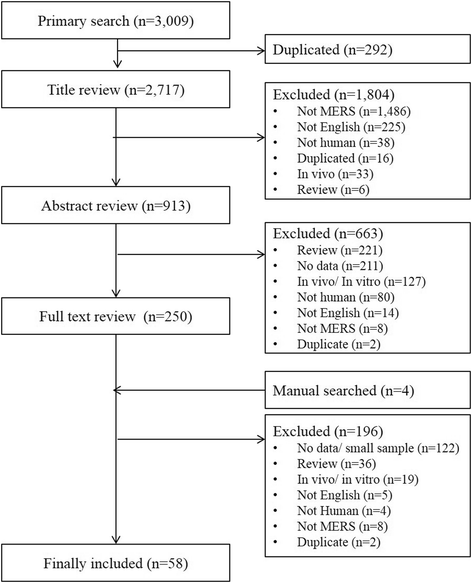MERS transmission and risk factors: a systematic review
- PMID: 29716568
- PMCID: PMC5930778
- DOI: 10.1186/s12889-018-5484-8
MERS transmission and risk factors: a systematic review
Abstract
Background: Since Middle East respiratory syndrome (MERS) infection was first reported in 2012, many studies have analysed its transmissibility and severity. However, the methodology and results of these studies have varied, and there has been no systematic review of MERS. This study reviews the characteristics and associated risk factors of MERS.
Method: We searched international (PubMed, ScienceDirect, Cochrane) and Korean databases (DBpia, KISS) for English- or Korean-language articles using the terms "MERS" and "Middle East respiratory syndrome". Only human studies with > 20 participants were analysed to exclude studies with low representation. Epidemiologic studies with information on transmissibility and severity of MERS as well as studies containing MERS risk factors were included.
Result: A total of 59 studies were included. Most studies from Saudi Arabia reported higher mortality (22-69.2%) than those from South Korea (20.4%). While the R0 value in Saudi Arabia was < 1 in all but one study, in South Korea, the R0 value was 2.5-8.09 in the early stage and decreased to < 1 in the later stage. The incubation period was 4.5-5.2 days in Saudi Arabia and 6-7.8 days in South Korea. Duration from onset was 4-10 days to confirmation, 2.9-5.3 days to hospitalization, 11-17 days to death, and 14-20 days to discharge. Older age and concomitant disease were the most common factors related to MERS infection, severity, and mortality.
Conclusion: The transmissibility and severity of MERS differed by outbreak region and patient characteristics. Further studies assessing the risk of MERS should consider these factors.
Keywords: Infectivity; MERS; Middle East respiratory syndrome; Mortality; Severity.
Conflict of interest statement
Ethics approval and consent to participate
Not applicable.
Competing interests
The authors declare that they have no competing interests.
Publisher’s Note
Springer Nature remains neutral with regard to jurisdictional claims in published maps and institutional affiliations.
Figures
References
-
- World Health Organization . WHO MERS-CoV global summary and risk assessment. 2016.
Publication types
MeSH terms
Grants and funding
LinkOut - more resources
Full Text Sources
Other Literature Sources
Medical


